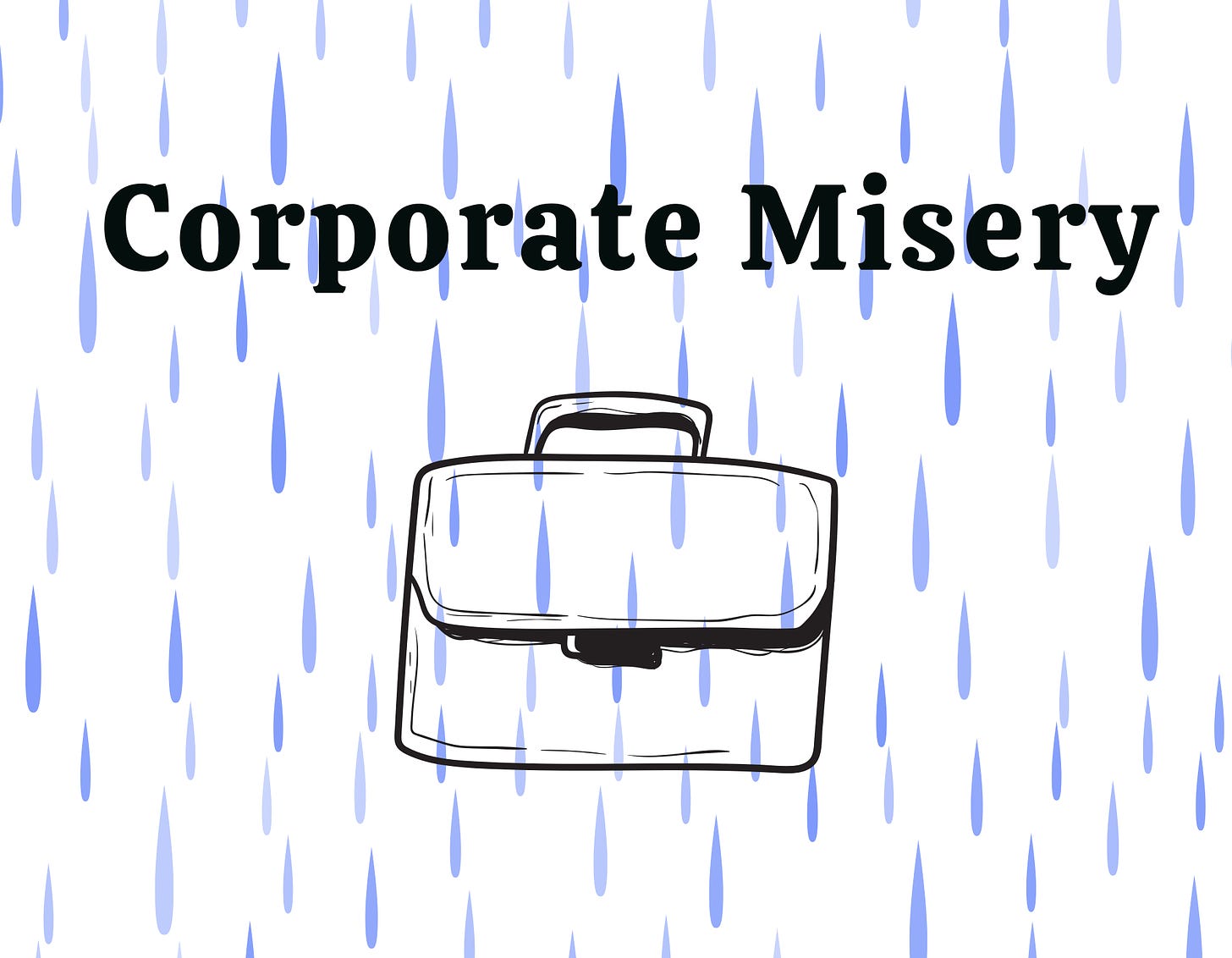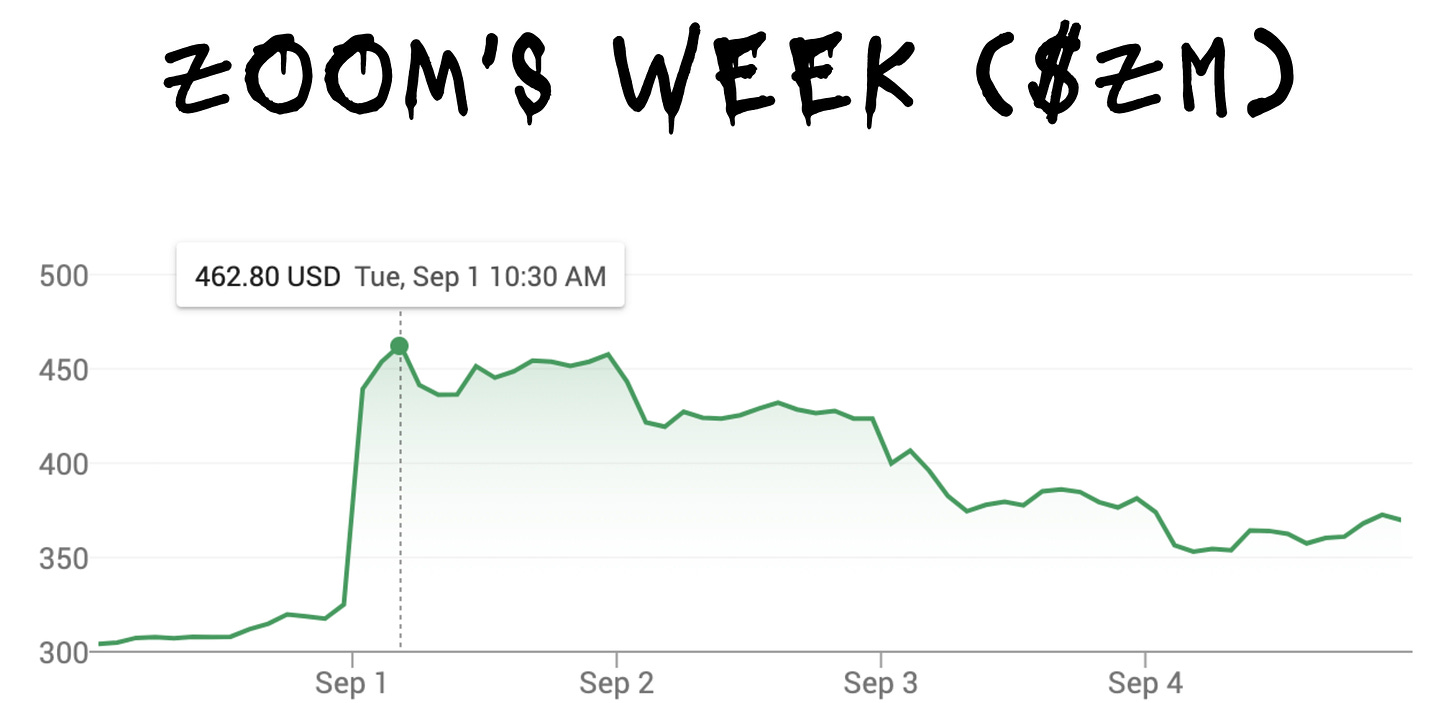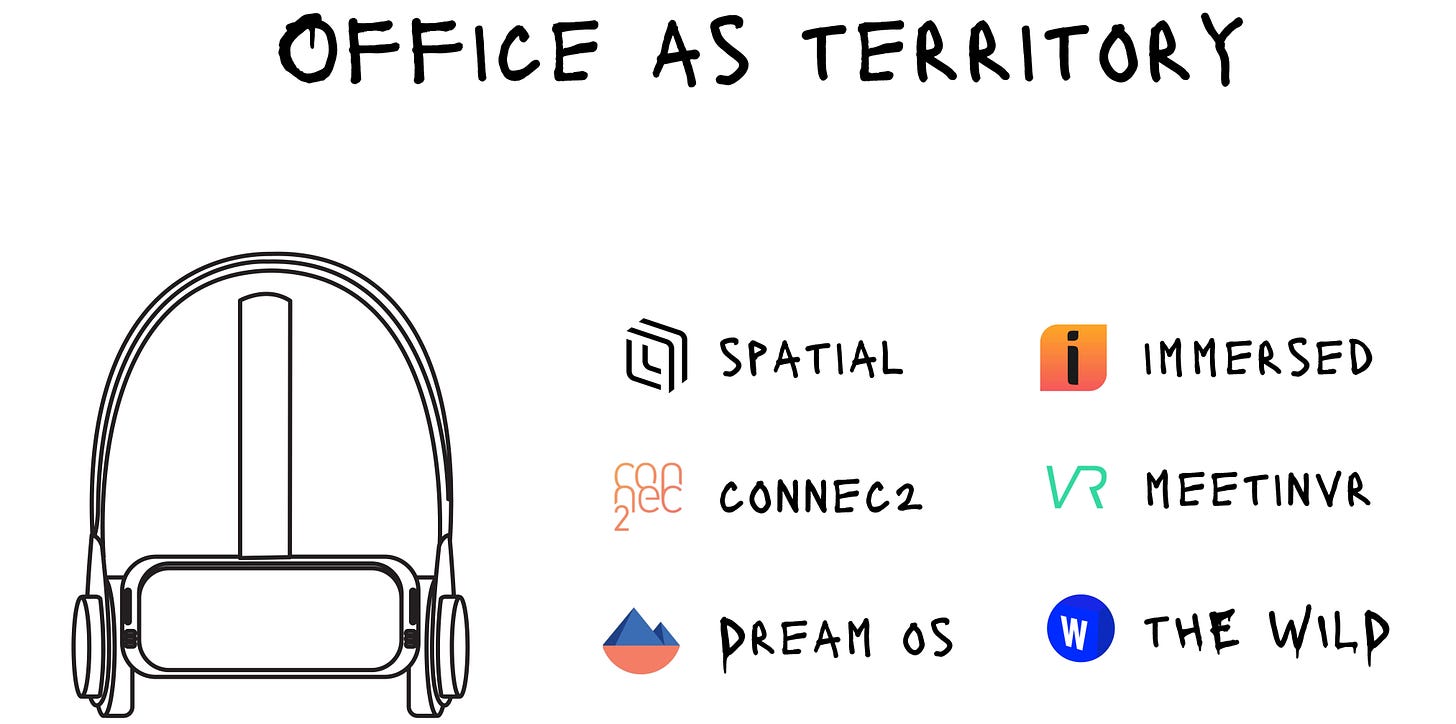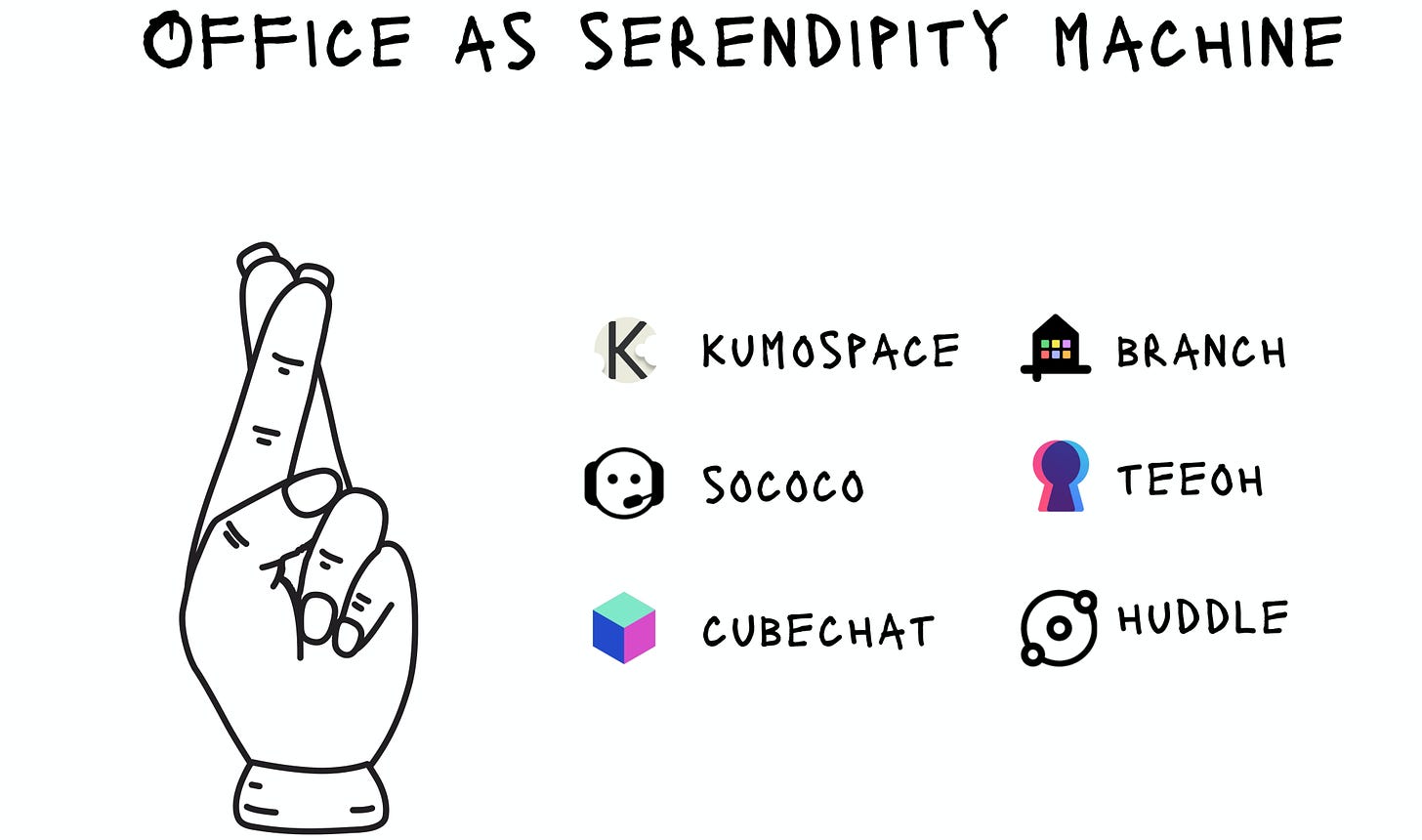Zoom, Unity and the Quest to Scale Corporate Drudgery

Brief: To build defensibility, Zoom may voyage into the murky world of metaverses, attempting to create a true virtual office. They should expect competition from gaming engines like Unity and a collection of upstarts.
There had been other, less distinguished jobs.
A summer as a grocery store bagger, waking at 4:30 am to walk in the already warm DC morning to wander an empty Harris Teeter. The short stint as a Macy’s suit salesman spent listening to the same co-worker list the many reasons Anderson Silva was the greatest MMA fighter of all time. The high school internship at a prestigious magazine — a privilege that became an exercise in tedium after it became clear no one would dare give me work. I arrived at a marble lobby in London, swiped a nametag, then guiltily read soccer news. After a few days, I tacked a Post-It over the desktop monitor’s clock to stop myself from checking it.
I do not find myself looking back at these periods with the rosy-tint Time sometimes lends us. None were what I would consider enjoyable, and yet when it comes to misery, they don’t approach what followed.
In the summer of 2012, I graduated from Columbia and began my first full-time job. Kobre & Kim is a small but respected litigation firm with offices around the world. As a twenty-two year old with a vague, unlettered interest in the law, I was enticed by the supposed rigor of their analyst program and seduced by the needlessly-competitive-so-it-must-be-desirable application process. Rather than shuffling papers like a paralegal, K&K gave promising Ivy grads the chance to really learn, helping compose briefs, draft exams, and contribute to case strategy.
I wasn’t sure what that meant, not really, but it sounded exciting and important and a very acceptable thing for a serious young graduate to do. I got the job.
If we accept Dante’s notion of Hell as a layered realm, a sort of subterranean car park of gloom, it should be said that my year at K&K hardly registers. This was no great tragedy, no life or death stakes, only a persistent and inescapable hollow feeling as if I were being scraped clean like a melon.
Every day, I arrived a tick before 9 am, made a coffee, unplugged my brain. I trudged to a cubicle in a sunless room — nicknamed “The War Room,” by the firm — and began my day. Emails, finicky copy jobs, phone call transcriptions. Binders, hole-punching, laminating. Counting time and billing hours. Lunch breaks and toilet breaks.
And document review, days of it.
For the better part of two months in the spring of 2013, I read through a decade of a client’s email correspondence, tagging each one with some version of: “relevant,” “not relevant,” and “high priority.” Quotas of emails reviewed were set, assiduously tracked. At the end of my life, I will wish for those weeks back.
A confession: I was terrible at this job.
I was terrible the day I began and knew nothing, and terrible the day I left. It is hard to be good at something you hate, and it’s one reason I don’t blame my employer. I am not sure it would have been possible to have provided a positive experience — it was not their fault the work I had been told I would do turned out to be so much more dreadful than I’d envisioned. I got staffed on cases that, when viewed from a distance, appeared interesting and probably were to others that worked on them. Though some colleagues shared my misery, others stayed for years, building prestigious legal careers.
But in the drab cubicle at which I sat, the depressive whine of the Keurig, the colorless invariability of time, K&K was my rendition of Office Space, cinema’s paean to corporate drudgery. Since the film’s release in 1999, other send-ups have captured popular attention by skewering the tedium of a 9 to 5, not least sitcoms like The Office, Workaholics, and The IT Crowd. Other artists have sought to capture that mundanity in virtual worlds. “Job Simulator - Office Worker” asks players to don a virtual reality headset just so they can fumble a bottle of coffee creamer, pulse a stress-relief ball, and log onto their computer. “It is as if you were doing work,” a maddeningly brilliant game from creator Pippin Barr asks users to type emails, fill out forms, and eke out an occasional break, providing a similarly humorous look at the office routine.
In its commitment to finding beauty and strangeness in boredom, these art forms bring to mind a quote from novelist John Updike:
We're past the age of heroes and hero kings... Most of our lives are basically mundane and dull, and it's up to the writer to find ways to make them interesting.
Increasingly, it’s not only up to the writer or artist, but the technologist too. As remote work untethers the employee from the office, person from place, digital platforms vie to take over. What may at first appear to be a skirmish over a preferred video conferencing system or a favored internal chat app could set the stage for something large: a battle to build the “Corporate Metaverse,” the virtual office of our dreams and nightmares.
The key combatants include Zoom, Unity, and a band of rebels.
Zoom: In search of defensibility
In an interview in March of this year, Eric Yuan painted an expansive vision for his company's future:
Imagine a world where, anywhere, any device, one click, you feel like you're in the same conference room … you can see each other and shake hands.
He went on to muse about the potential to one day smell a cup of coffee in such a call. Far from portraying the incremental growth of a conferencing product, Yuan laid a grounding vision for a Corporate Metaverse, a place in which work is done, connections are made, touch and presence is felt.
In some respects, it’s an argument the company may be at even greater pains to make six months later. The intervening period has seen Zoom’s stock price increase 3.5x since that interview was published, trading at an EV/EBITDA multiple of +1,800. Cisco, Yuan’s alma mater, registers at 11.83. Exceptional performance has driven this run-up — Q2 saw the company achieve revenue growth of 355% annualized — and yet the sense remains that Zoom is a susceptible Goliath.

For all its growth, this is a company without enduring defensibility or a clear accumulating advantage. In a piece written earlier this summer, Benedict Evans, formerly of Andreessen Horowitz, asked, “What comes after Zoom?” Despite tracing the stock market equivalent of a supernova, there is the feeling that Zoom’s time in the sun is already up.
The solution could be to embrace Yuan’s sci-fi vision more explicitly. As it stands, Zoom is locked in a classic Innovator’s Dilemma. Good management and sound judgment would dictate they ignore such flights of fancy and focus. Improve the core product's reliability and security, beguile large customers as they have with Exxon and Activision, grow contract value as with Service Now. Do the boring stuff well.
That may be enough for now, but it will not solve Zoom’s core weaknesses. Network effects cannot manifest from a slicker sales process or stronger encryption. But a metaverse — an interactive virtual office — might provide sufficient differentiation for Zoom to require users to have an account. In so doing, Zoom could reclaim the defensibility forfeited by allowing unregistered users to access the service.
This would be a radical move and a challenge for an organization that has hardly excelled from a product design standpoint. Though the core technology ensures a performant system, navigating the platform remains unintuitive. For all Zoom’s success, they may not have the competency to create a compelling functional world. And yet, there are few better avenues that offer the chance to become a truly generational business.
Unity: A world-builder with corporate ambitions
No such product limitations apply to Unity, poised to make its public market debut over the next couple weeks.
If I’ve learned one thing from reviewing the company’s S-1 filing, it’s this: Unity does not consider itself a gaming company. Far from focusing their vision on play, the firm has designs on serving architectural, automotive, and engineering clients, among others. While much of this rhetoric centers around how the Unity engine can level-up design challenges — think modeling a car, or mapping out a bridge — is it farfetched to believe the company might pursue a more quotidian vision?
With 53% of the top 1000 mobile games relying on the company’s engine, Unity already powers high-fidelity worlds at scale. How difficult could it be to spin up a cubicle and a coffee machine?
In the near-term, Unity has other priorities. Though the engine has already been used by high profile corporate clients like Autodesk, this part of their business remains underbuilt. Beyond that, the firm’s infrastructural focus also makes them unlikely to challenge for the frontend of such an experience, barring a volte-face in strategy. In that respect, Unity might make an interesting partner for a consumer-facing product like Zoom — or even a left-field acquisition target.

Unity’s last round of private funding valued the company at $6B. Even if they reach the public market at 3x that price, that $18B figure would be less than half the market cap Zoom accumulated between August 31st and September 1st. There are worse places Yuan and Co. could spend their low-latency lucre.
(Aside: expect more news on Unity’s S-1 this coming week. Here’s the team we’ve assembled for this edition of The S-1 Club.)
The rebels: Brave new worlds
Over the past couple years — accelerating since the outbreak of the pandemic — a band of upstarts have entered the fray, angling for a slice of the Corporate Metaverse. Each offers a slightly different view of the future of work, varying interpretations of the purpose and form of an “office.”
Among this fractal spread are three core conceptions: the office as a territory, the office as a to-do list, and the office as a serendipity machine.
The Office as a Territory: VR platforms
Virtual reality platforms see the office as a territory, a zone to be entered and exited. By requiring a headset, VR products treat the simulacra of an office as a real place that mandates the user make a choice: either be present or leave.
One example is Spatial. A recipient of a $14M Series A round earlier this year, Spatial hosts VR and AR meetings. Users construct detailed avatars that then enter virtual rooms replete with whiteboards, post-it notes, screen-sharing, and 3D models. As Spatial describes it, “Your room is your monitor, your hands are the mouse.” While Spatial allows non-headset wearers to interact with the platform, there is a clear preference for full, self-contained immersion.

Connec2, a Dutch business, offers a similar premise showcasing a standard conference room inhabited by metallic-colored humanoids with disembodied hands. Immersed, MeetinVR, and Dream OS offer almost identical benefits, each stylizing avatars to varying degrees and offering meetings in caves, outer space, or in the clouds. The Wild provides a similar range of tools but focuses on architects and industrial designers.
The question for companies in this category is simple: what does your world give us? What does it allow us to do beyond our existing tools? If we’re going to give up the comfort of our apartment sofa, the enjoyable sense of embodiment, what do we get in return?
For Spatial and its cohort, success relies on delivering meaningful intimacy and functionality above and beyond Zoom, Slack, and other remote tooling.
The Office as a To-Do List: Collaboration tools
What is an office, anyway?
For collaboration tools in this space, the workplace is not a location to skeuomorph but a series of jobs-to-be-done. Its purpose is defined by its output.
There is the job of feedback, co-authorship, instruction, delegation, all solvable through “virtual office” platforms like Tandem, Pragli, Vizy, Embryo, and With. Around and Macro, both recipients of recentseed funding, take a similar approach to the tools above, though position themselves as video conferencing products.

Users log on, chat with co-workers, pull up a video call, and jump into a Sketch file or Google Doc. Work is not a place, but a chain of tasks and interactions solved with product features. The office is abstractable.
There are some nods to socialization. Video and chat allow for communication though of the more concerted, transactional variety. Concepts like a “water cooler” channel gesture towards serendipity without giving it much space. It may not matter — culture and camaraderie may thrive regardless, or prove less critical than once imagined.
As with the previous cohort, there is a clear trade-off: efficiency and structure over socialization.
The Office as a Serendipity Machine: Work maps
Steve Jobs was not a fan of working from home.
There's a temptation in our networked age to think that ideas can be developed by email and iChat — that's crazy. Creativity comes from spontaneous meetings, from random discussions. You run into someone, you ask what they're doing, you say 'Wow,' and soon you're cooking up all sorts of ideas.
The office is not the representation of tasks, it’s the foundation for serendipity. This is the view of “work map” startups like Kumospace.
The startup, which I featured in a recent edition of In Flight, creates virtual rooms, viewed aerially, and traversable via avatar. This allows for fluid socialization, as users move between groups. A headset is not required, making it easier for users to keep the platform open for extended periods and thus prolonging the opportunity for interaction. Unlike a traditional video call, which is prescriptive in its format, Kumo makes formation and configuration an individual decision, just as in real life. If you want to move to chat one-on-one with a friend, you can. If you’d like to stand in a cluster, no problem. Completing tasks is not the focus; making connections is. In that respect, Kumo is not only for the office — it could be used just as well by friends, clubs, and other groups.

Analogous companies include Sococo and Branch, while Teeoh, Huddle, and CubeChat take slightly different tacts focusing on events, integrating task management, or adding in more advanced game mechanics.
Work maps look to replace what the pandemic has stripped us of most directly. While most of us navigated various collaboration tools regardless of whether we worked from home or not in the past, we never would have meandered around a map of our office. Stuck at home and starved for contact, serendipitous interaction suddenly feels like a much more acute need.
Startups in this space must ask themselves whether such a need will remain in a post-virus world.
* * *
What do we want, as workers? Freed from the deadness of the cubicle, the patronization of the ping-pong table, what do we hope takes its place?
For its life-sapping qualities, Kobre & Kim did have one redeeming feature. In the lightless War Room that Time forgot, five of us, coworkers, became enduring friends. Over the course of a year, we developed intricate, long-running jokes, concocted shared rituals, performed harmless pranks on one another. As much as friendship, we created habits, a sort of culture in miniature.
There is an implicit tension between the different visions of the office we have discussed, in particular, the latter two. If the office is a series of tasks to be optimized, what room is there for socialization? If the office is a serendipity-machine, where does work occur?
What about the office as a territory, accessible only by VR headset? The commute will return long before we descend into the synthetic world of Magic Leap, surely.
And so, if we assume Zoom and Unity will not conquer this territory in the short-to-medium term, what approach gives startups the best chance, the path of fastest growth? Perhaps the tension between efficiency and fraternity will dissolve over time as collaboration tools borrow features from work maps, and visa-versa.
In all likelihood, there will be space for more than one winner. We will always need better task management platforms, systems to facilitate collaboration, places to make friends, and connections. We will see video calling in some instantiation for a long time to come.
Maybe we will move towards a system of parallel offices, parallel universes, each designed for a different interaction. We will wake, walk to the kitchen, make a coffee, then plug in our worlds. The era of the Corporate Metaverse may never come. Instead, we may be entering the age of the Corporate Multiverse.
In other news
Here’s a recap of what happened in The Generalist community this week.
In Flight. Mem.ai has become my go-to notetaking tool and task manager. I dug into what the startup is building and gave subscribers a chance to access the closed beta. More here
The Not Boring Generalists. Packy and I talked about Zoom's earnings, outlining part of the argument made in today's essay. More here (video)
There are some fun events coming up. Stay tuned for more news.
Unpacking Unity's IPO. Patrick O'Shaughnessy, Meera Clark, Dave Ambrose, Adam Keesling, Packy McCormick, and I are going to discuss our analysis of Unity in advance of the company's IPO. Join us Thursday, September 10th. More here
Puzzler
What has six faces, but no mouths?
Twenty-one eyes, but cannot see?
As always, clues given to those curious enough to message. All efforts welcomed, no matter how speculative.
Aisling S quickly sniffed out the right answer to last week's especially tricky riddler. They were joined by the admirable pairing of NMT and Rishi R.
Whoever makes it, takes it not.
Whoever takes it, knows it not.
Whoever knows it, wants it not.
What is it?
The answer? Counterfeit money. Before providing the stated answer, Rishi also offered some intriguing alternatives including "data" and "a bet." Jamie M suggested "coffin" as a response. Well-reasoned.
Thank you all for reading. I hope you have a leisurely Sunday, and for the American readers, a pleasant Monday off.
Mario
PS — I always love hearing from you. If you have thoughts, please do write in. And if you have a friend you think might enjoy The Generalist, I'd really appreciate you sharing.
PPS —If you're interested in seeing this newsletter's progression, you can check out The Generalist's "changelog." More here
What did you think of this edition?


